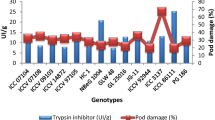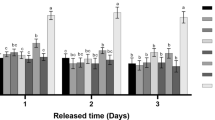Abstract
The noctuid pod borer, Helicoverpa armigera is one of the most damaging pests of chickpea, Cicer arietinum. The levels of resistance to H. armigera in the cultivated chickpea are low to moderate, but the wild relatives of chickpea have exhibited high levels of resistance to this pest. To develop insect-resistant cultivars with durable resistance, it is important to understand the contribution of different components of resistance, and therefore, we studied antixenosis and antibiosis mechanisms of resistance to H. armigera in a diverse array of wild relatives of chickpea. The genotypes IG 70012, PI 599046, IG 70022, PI 599066, IG 70006, IG 70018 (C. bijugum), ICC 506EB, ICCL 86111 (cultivated chickpea), IG 72933, IG 72953 (C. reticulatum), IG 69979 (C. cuneatum) and IG 599076 (C. chrossanicum) exhibited non preference for oviposition by the females of H. armigera under multi-choice, dual-choice and no-choice cage conditions. Based on detached leaf assay, the genotypes IG 70012, IG 70022, IG 70018, IG 70006, PI 599046, PI 599066 (C. bijugum), IG 69979 (C. cuneatum), PI 568217, PI 599077 (C. judaicum) and ICCW 17148 (C. microphyllum) suffered significantly lower leaf damage, and lower larval weights indicating high levels of antibiosis than on the cultivated chickpea. Glandular and non-glandular trichomes showed negative correlation with oviposition, while the glandular trichomes showed a significant and negative correlation with leaf damage rating. Density of non-glandular trichomes was negatively correlated with larval survival. High performance liquid chromatography (HPLC) fingerprints of leaf surface exudates showed a negative correlation of oxalic acid with oviposition, but positive correlation with malic acid. Both oxalic acid and malic acid showed a significant negative correlation with larval survival. The wild relatives exhibiting low preference for oviposition and high levels of antibiosis can be used as sources of resistance to increase the levels and diversify the basis of resistance to H. armigera in cultivated chickpea.




Similar content being viewed by others
References
Babu GC, Sharma HC, Madhumati T, Raghavaiah G, Murthy KVMK, Rao VS (2014) A semi-synthetic chickpea flour based diet for long-term maintenance of laboratory culture of Helicoverpa armigera. Indian J Entomol 76:336–340
Bernays EA, Champman RF (1994) Host plant selection by phytophagopus insects. Chapman & Hall, New York
Chen W, Sharma HC, Muehlbauer F (2011) Chickpea and lentil crop protection compendium. American Phytopathological Society, St Paul
Cowgill SE, Lateef SS (1996) Identification of antibiotic and antixenotic resistance to Helicoverpa armigera (Lepidoptera: Noctuidae) in chickpea. J Econ Entomol 89:224–229
FAO STAT (2014) Food and Agriculture Organisation of the United Nations 2002. IOP Publishing FAO. http://apps.fao.org
Girija SPM, Patil SA, Gowda CLL, Sharma HC (2008) Biophysical and biochemical basis of host plant resistance to pod borer, Helicoverpa armigera (Hubner) in chickpea (Cicer arietinum L.). Indian J Genet Plant Breed 68:320–323
Green PWC, Stevenson PC, Simmonds MSJ, Sharma HC (2002) Can larvae of the pod borer, Helicoverpa armigera (Lepidoptera: Noctuidae), select between wild and cultivated pigeonpea Cajanus sp. (Fabaceae)? Bull Entomol Res 92:45–51
Hajjar R, Hodgkin T (2007) The use of wild relatives in crop improvement: a survey of developments over the last 20 years. Euphytica 156:1–13
Hossain MA, Haque MA, Prodhan MZH (2008) Effect of pods characteristics on pod borer, Helicoverpa armigera (Hubner), investigation in chickpea. SAARC J Agric 6(1):1–11
Jackai LEN, Oghiakhe S (1989) Pod wall trichomes and role in the resistance of two wild cowpea, Vigna vexillata accessions to Maruca testulalis (Geyer), (Lepidoptera: Pyralidae) and Clavigralla tomentosicollois, (Hemiptera: Coreidae). Bull Entomol Res 79:595–605
Kranthi KR, Jadhav DR, Kranthi S, Wanjari RR, Ali SS, Russel DA (2002) Insecticide resistance in five major insect pests of cotton in India. Crop Prot 21:449–460
Kulkarni US, Gawande RB, Kulkarni SS, Yadgirwar PV (2004) Comparative studies on the biology of Helicoverpa armigera on different food substrates. J Soils Crops 14:207–208
Kumari DA, Reddy DJ, Sharma HC (2006) Antixenosis mechanism of resistance in pigeonpea to the pod borer, Helicoverpa armigera. J Appl Entomol 130(1):10–14
Maiti RK, Bidinger FR (1979) Simple approaches to the identification of shoot fly tolerance in sorghum. Indian J Plant Prot 7:135–140
Narayanamma VL, Sharma HC, Vijay PM, Gowda CLL, Sriramulu M (2013) Expression of resistance to the pod borer Helicoverpa armigera (Lepidoptera: Noctuidae), in relation to high-performance liquid chromatography fingerprints of leaf exudates of chickpea. Int J Trop Insect Sci 33(4):276–282
Navasero RC, Ramaswamy SB (1991) Morphology of leaf surface trichomes and its influence on egglaying by Heliothis virescens. Crop Sci 31:342–353
Nimbalkar RK, Shinde SS, Tawar DS, Muley SP (2009) Response of cotton bollworm Helicoverpa armigera (Hubner) (Lepidoptera: Noctuidae) to different insecticides in Maharashtra, India. World J Agric Sci 5(2):250–255
Peter AJ, Shanower TG (1998) Plant glandular trichomes: chemical factories with many potential uses. Resonance 3:41–45
Peter AJ, Shanower TG, Romeis J (1995) The role of plant trichomes in insect resistance: a selective review. Phytophaga 7:41–64
Pundir RPS, Mangesha MH (1995) Cross compatibility between chickpea and its wild relative Cicer echinospermum Davis. Euphytica 83:241–245
Rembold H (1981) Malic acid in chickpea exudates a marker for Heliothis resistance. Int Chickpea Newsl 4:18–19
Romeis J, Shanower TG, Peter AJ (1999) Trichomes on pigeonpea (Cajanus cajan) and two wild Cajanus spp. Crop Sci 39:564–569
Ruan YM, Wu KJ (2001) Performances of the cotton bollworm, Helicoverpa armigera on different food plants. Acta Entomol 44:205–212
Sarode SV (1999) Sustainable management of Helicoverpa armigera (Hubner). Pestology 13(2):279–284
Sarwar M, Ahmad N, Toufiq M (2009) Host plant resistance relationships in chickpea (Cicer arietinum L.) against gram pod borer (Helicoverpa armigera Hubner). Pak J Bot 41(6):3047–3052
Shabbir MZ, Arshad M, Hussin B, Nadeen I, Ali S, Abbasi A, Ali Q (2014) Genotypic response of chickpea (Cicer arietinum L.) for resistance against gram pod borer (Helicoverpa armigera). Adv Life Sci 2(1):23–30
Shahzad K, Iqbal A, Khalil SK, Khattak S (2005) Response of different chickpea (Cicer arietinum) genotypes to the infestation of pod borer (Helicoverpa armigera) with relation to trichomes. Res J Agric Biol Sci 1(1):120–124
Sharma HC, Pampapathy G, Lanka SK, Ridsdill-Smith TJ (2004) Evaluation of wild relatives of chickpea (Cicer spp.) for resistance to pod borer, Helicoverpa armigera (Hubner). Indian J Plant Genet Resour 17(1): 17–26
Sharma HC, Ahmad R, Ujagir R, Yadav RP, Singh R, Ridsdill-Smith TJ (2005a) Host plant resistance to cotton bollworm/legume pod borer, Heliothis/Helicoverpa. In: Sharma HC (ed) Heliothis/Helicoverpa management: emerging trends and strategies for future research. Oxford and IBH Publishing, New Delhi, pp 167–208
Sharma HC, Pampapathy G, Lanka SK, Ridsdill-Smith TJ (2005b) Exploitation of wild Cicer reticulatum germplasm for resistance to Helicoverpa armigera. J Econ Entomol 98(6):2246–2253
Sharma HC, Pampapathy G, Lanka SK, Ridsdill-Smith TJ (2005c) Antibiosis mechanism of resistant to pod borer, Helicoverpa armigera in wild relatives of chickpea. Euphytica 142:107–117
Sharma HC, Bhagawat MP, Pampapathy G, Sharma JP, Ridsdill-Smith TJ (2006) Perennial wild relatives of chickpea as potential sources of resistance to Helicoverpa armigera. Genet Resour Crop Evol 53:131–138
Simmonds MSJ, Stevenson PC (2001) Effects of isoflavonoid from Cicer arietinum on larvae of Helicoverpa armigera. J Chem Ecol 27(5):965–977
Srivastava CP, Srivastava RP (1989) Screening for resistance to gram podborer, Heliothis armigera (Hubner), in chickpea (Cicer arientium L.) genotypes and observations on its mechanism of resistance in India. Insect Sci Appl 10(3):255–258
Suzana CS, Damiani R, Fortuna LS, Salvadori JR (2015) Desempenho de larvas de Helicoverpa armigera (Hübner) (Lepidoptera: Noctuidae) em diferentes fontes alimentares. Pesquisa Agropecu Trop 43:480–485
Udayagiri S, Mason CE (1995) Host plant constituents as oviposition stimulants for a generalist herbivore: European corn borer. Entomol Exp Appl 76:59–65
Van der Maesen LJG, Maxted N, Javadi F, Coles S, Davies AMR (2007) Taxonomy of the genus Cicer revisited. In: Yadav SS, Redden RJ, Chen W, Sharma B (eds) Chickpea breeding and management. CAB International, Wallingford, pp 14–46
Yoshida M, Cowgill SE, Wightman JA (1995) Mechanisms of resistance to Helicoverpa armigera (Lepidoptera: Noctuidae) in chickpea—role of oxalic acid in leaf exudates as an antibiotic factor. J Econ Entomol 88:1783–1786
Yoshida M, Cowgill SE, Wightman JA (1997) Roles of oxalic and malic acids in chickpea trichome exudate in host-plant resistance to Helicoverpa armigera. J Chem Ecol 23(4):1195–1210
Acknowledgements
We thank the entomology staff at ICRISAT, Patancheru, for their support in carrying out these experiments. The financial support provided by Department of Science and Technology (DST), New Delhi, India, under INSPIRE Fellowship scheme to Mr. Siva Kumar is gratefully acknowledged.
Funding
This study was not funded by any organization.
Author information
Authors and Affiliations
Contributions
HC, PR and SK conceived and designed the research. SK conducted the experiments, analyzed the results and wrote the paper. SP and HP helped in data analysis and contributed in preparing manuscript. All the authors read and approved the manuscript.
Corresponding author
Ethics declarations
Conflict of interest
The authors declare that they have no conflict of interest.
Ethical approval
This article does not contain any studies with human participants or animals performed by any of the authors.
Informed consent
This is not applicable as this article does not contain any studies with human participants performed by any of the authors.
Rights and permissions
About this article
Cite this article
Golla, S.K., Rajasekhar, P., Sharma, S.P. et al. Antixenosis and antibiosis mechanisms of resistance to pod borer, Helicoverpa armigera in wild relatives of chickpea, Cicer arietinum. Euphytica 214, 88 (2018). https://doi.org/10.1007/s10681-018-2168-5
Received:
Accepted:
Published:
DOI: https://doi.org/10.1007/s10681-018-2168-5




